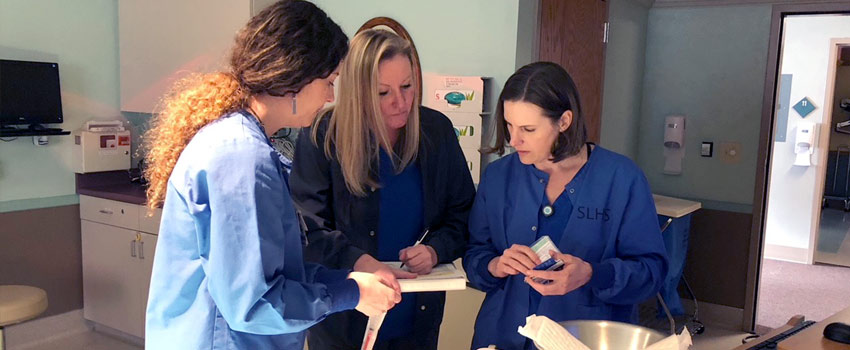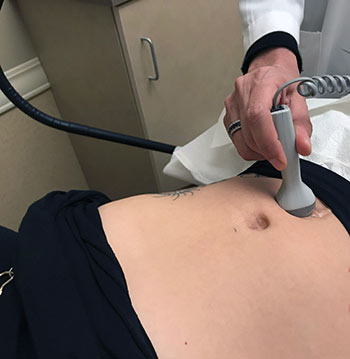Dr. Pate’s Prescription for Change
St. Luke’s Women’s Services makes maternal health a priority


My daughters were pregnant at the same time. While watching their pregnancies progress, seeing the ultrasounds and listening to the infants’ heartbeats, I worried about the well-being of the babies – would they be healthy?
One daughter was having twins and I worried about the babies being born prematurely. It was not until later that I learned that maternal morbidity and mortality in the U.S. is among the highest in the world. I’m glad I didn’t realize that at the time and have that to add to my list of worries.
It is hard to comprehend that here in the United States, where we have some of the best health care in the world, maternal morbidity and mortality remain a significant concern. Here to tell you what St. Luke’s is doing to address this problem is Alexis Bennett, St. Luke’s Health System content coordinator.
- David C. Pate, M.D., J.D.
The United States is the only developed nation that continues to experience rising rates of maternal mortality and morbidity, and has the highest rate of maternal death among developed countries.
Among the states, Idaho fares badly, ranking 13th of 47 reporting maternal death rates. This equates to 27.1 deaths per 100,000 births.
In the face of these disconcerting statistics, St. Luke’s has jumped in, implementing and tracking measures in clinical education and system and process improvements.
Early results are encouraging to Dr. Stacy Seyb, Women’s Service Line medical director, and his team, including Women’s Services Program Manager Julya Miner.
During the fiscal year that ended last fall, St. Luke’s saw a 35 percent reduction in median rate of massive transfusions, a 77 percent reduction in maternal ICU admissions and an overall transfusion reduction of about 33 percent. This means fewer hemorrhage escalations, less time at the hospital and lower costs for obstetrics patients and reduced risk for delivering mothers.
“It’s a big win, and we’ll be more excited if it continues into next year,” Miner said.
Prepared for Anything
The team has focused especially on the risk of obstetrical hemorrhage and the staff education that can counter problems that might arise.
Women’s services has begun using Relias OB, a self-guided e-learning platform that validates clinician proficiency, knowledge and judgment related to the management of emergencies through a pre-assessment. Tied to physician compensation and certification, Relias training is a requirement for all obstetrics nursing staff and has significantly improved outcomes, in large part because it puts all members of the care team on the same page when it comes to standard protocol in delivery of care.
“The modules are geared to help the team in the areas where they most need it across all of our clinics,” Miner said. “It’s not a one-size-fits-all if teams need one thing in Magic Valley and another in McCall. They can get the education they need without sitting through a four-hour class about information they already know.”
The program has saved nursing-related training hours and expenses, and providers feel they get the information they need to keep patients safe without reviewing everything every year. This is especially important in more isolated geographical areas and for OBs who do fewer deliveries—they stay sharp.
That level of preparedness can be reassuring to expectant parents.
“As a first-time mom, the idea of giving birth in general can be overwhelming and, at times, terrifying,” St. Luke’s patient Nicole Keisel said. “When I enter the hospital space, I should know that I am in good hands, surrounded by those who will help me have the best birth possible, and that are well-prepared to look for warning signs and be proactive if something should go wrong.”
Measures to Improve Decision-Making
California is one of the only states to turn around rates of mortality, in part through the California Maternal Quality Care Collaborative (CMQCC). SLHS Women’s Services has looked to the CMQCC’s perinatal safety bundles for guidance as they align response teams, response protocols and algorithms.
CMQCC’s evidence-based practices help inform what happens in St. Luke’s delivery rooms. Standardizing practices, for example, reduces delayed recognition and delayed response, a critical advantage since time can mean the difference between a positive and negative outcome.
Simulation, as recommended by Relias, has also influenced standard practice. Teams practice responding to stressful situations, such as hemorrhage or hypertensive crisis, and learn to resolve the issue while not under duress, identifying system breakdowns along the way. Recommended improvements are made, and then there’s another simulation to practice those solutions.
As a result of what’s been learned through simulation and education, among other improvements, St. Luke’s has:
- Ensured OB hemorrhage carts as standard equipment in delivery rooms;
- Standardized its approach to quantifying blood loss during deliveries;
- Standardized its definition of hemorrhage based on blood-loss volume; and
- Implemented administration of Transexamic Acid (TXA) as part of intervention protocol, which is especially important at limited-access facilities with limited supplies of blood products for transfusion.

All of the initiatives have combined to produce dramatic improvements in a very short period of time, and so far, the focus has been in acute care to reduce mortality rates. Long-term, Dr. Seyb’s team realizes that there’s opportunity to build on its success by expanding awareness around co-morbidities, such as diabetes, sepsis, preeclampsia and hypertension, that can accompany stroke and seizure, which could reduce the need for intervention in delivery rooms.
Providers as Advocates
Until Mar. 2019, Idaho was one of seven states without a state committee solely dedicated to the review of pregnancy-related and -associated deaths. This meant that incident review was not mandated and fell to individual hospitals and systems, if it happened at all. The inconsistency translates to an inability to fully understand the circumstances behind deaths.
“Some of the difficulty with benchmarking (our data) against other systems locally and nationally is the discrepancies in definitions,” Miner said.
St. Luke’s completes its own internal review to guide improvements and analyzes trends in incidents, situations and subsequent actions to understand ways to improve practice. The issue is greater than St. Luke’s Health System, though.
“Last year, just over 700 American women died as a result of pregnancy-related complications,” Miner said. “That equates to about two mothers every day. Care teams, families, and communities are impacted by these deaths.
“At St. Luke’s, our commitment to creating a safer pregnancy and delivery experience for our patients is one way we’re making good on our promise to improve the health of people in the communities we serve.”
About The Author

Alexis Bennett is a consultant for St. Luke's Community Health and Engagement.



